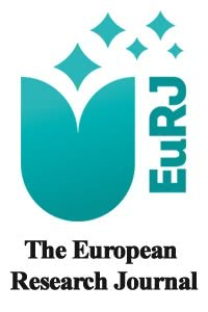Next-generation sequencing panel test results in pediatric patients with progressive familial intrahepatic cholestasis: a single-center experience
Next-generation sequencing panel test results in pediatric patients with progressive familial intrahepatic cholestasis: a single-center experience
Progressive familial intrahepatic cholestasis, novel, ABCB11, ABCB4 ATP8B1,
___
- 1. Langedijk JAGM, Beuers UH, Oude Elferink RPJ. Cholestasis-associated pruritus and its pruritogens. Front Med (Lausanne) 2021;8:639674.
- 2. Chen HL, Wu SH, Hsu SH, Liou BY, Chen HL, Chang MH. Jaundice revisited: recent advances in the diagnosis and treatment of inherited cholestatic liver diseases. J Biomed Sci 2018;25:75.
- 3. Jones-Hughes T, Campbell J, Crathorne L. Epidemiology and burden of progressive familial intrahepatic cholestasis: a systematic review. Orphanet J Rare Dis 2021;16:255.
- 4. Alam S, Lal BB. Recent updates on progressive familial intrahepatic cholestasis types 1, 2 and 3: Outcome and therapeutic strategies. World J Hepatol 2022;14:98-118.
- 5. Herbst SM, Schirmer S, Posovszky C, Jochum F, Rödl T, Schroeder JA, et al. Taking the next step forward - Diagnosing inherited infantile cholestatic disorders with next generation sequencing. Mol Cell Probes 2015;29:291-8.
- 6. Stenson PD, Mort M, Ball EV, Howells K, Phillips AD, St Thomas N, et al. The human gene mutation database: 2008 update. Genome Med 2009;1:13.
- 7. Richards S, Aziz N, Bale S, Bick D, Das S, Gastier-Foster J, et al. Standards and guidelines for the interpretation of sequence variants: A joint consensus recommendation of the American College of Medical Genetics and Genomics and the Association for Molecular Pathology. Genet Med 2015;17:405-24.
- 8. Karczewski KJ, Francioli LC, Tiao G, Cummings BB, Alföldi J, Wang Q, et al. The mutational constraint spectrum quantified from variation in 141,456 humans. Nature 2020;581:434-43.
- 9. Zhang W, Lin R, Lu Z, Sheng H, Xu Y, Li X, et al. Phenotypic and molecular characteristics of children with progressive familial intrahepatic cholestasis in south China. Pediatr Gastroenterol Hepatol Nutr 2020;23:558-66.
- 10. Vitale G, Gitto S, Vukotic R, Raimondi F, Andreone P. Familial intrahepatic cholestasis: new and wide perspectives. Dig Liver Dis 2019;51:922-33.
- 11. Felzen A, Verkade HJ. The spectrum of Progressive Familial Intrahepatic Cholestasis diseases: Update on pathophysiology and emerging treatments. Eur J Med Genet 2021;64:104317.
- 12. Klomp LW, Vargas JC, van Mil SW, pawlikowska L, Strautnieks SS, van Eijk MJT, et al. Characterization of mutations in ATP8B1 associated with hereditary cholestasis. Hepatology 2004;40:27-38.
- 13. Clouston AD. Pathologic features of hereditary cholestatic diseases. Surg Pathol Clin 2018;11:313-27.
- 14. Vitale G, Gitto S, Raimondi F, Mattiaccio A, Mantovani V, Vukotic R, et al. Cryptogenic cholestasis in young and adults: ATP8B1, ABCB11, ABCB4, and TJP2 gene variants analysis by high-throughput sequencing. J Gastroenterol 2018;53:945-58.
- 15. Mínguez Rodríguez B, Molera Busoms C, Martorell Sampol L, García Romero R, Colomé Rivero G, Martín de Carpi J. Heterozygous mutations of ATP8B1, ABCB11 and ABCB4 cause mild forms of Progressive Familial Intrahepatic Cholestasis in a pediatric cohort. Gastroenterol Hepatol 2022;45:585-92.
- 16. Jeyaraj R, Bounford KM, Ruth N, Lloyd C, MacDonald F, Hendriksz CJ, et al. The genetics of inherited cholestatic disorders in neonates and infants: evolving challenges. Genes (Basel) 2021;12:1837.
- 17. Al-Hussaini A, Lone K, Bashir MS, Alrashidi S, Fagih M, Alanazi A, et al. ATP8B1, ABCB11, and ABCB4 genes defects: novel mutations associated with cholestasis with different phenotypes and outcomes. J Pediatr 2021;236:113-23.e2.
- 18. Kang HJ, Hong SA, Oh SH, Kim KM, Yoo HW, Kim GH, et al. Progressive familial intrahepatic cholestasis in Korea: a clinicopathological study of five patients. J Pathol Transl Med 2019;53:253-60.
- 19. Goldberg A, Mack CL. Inherited cholestatic diseases in the era of personalized medicine. Clin Liver Dis (Hoboken) 2020;15:105-9.
- 20. Lipiński P, Ciara E, Jurkiewicz D, Pollak A, Wypchło M, Płoski R, et al. Targeted next-generation sequencing in diagnostic approach to monogenic cholestatic liver disorders-single-center experience. Front Pediatr 2020;8:414.
- 21. Nicastro E, Di Giorgio A, Marchetti D, Barboni C, Cereda A, Iascone M, et al. Diagnostic yield of an algorithm for neonatal and infantile cholestasis integrating next-generation sequencing. J Pediatr 2019;211:54-62.e4.
- 22. Bakır A, Topçu V, Çavdarlı B. The molecular landscape of progressive familial intrahepatic cholestasis in Turkey: defining the molecular profiles and expanding the variant spectrum. Ann Hum Genet 2022;86:119-26.
- 23. Shagrani M, Burkholder J, Broering D, Abouelhoda M, Faquih T, El-Kalioby M, et al. Genetic profiling of children with advanced cholestatic liver disease. Clin Genet 2017;92:52-61.
- ISSN: 2149-3189
- Yayın Aralığı: 6
- Başlangıç: 2015
- Yayıncı: Prusa Medikal Yayıncılık Limited Şirketi
A case developing bilateral bullae due to COVID-19 infection and operated for recurrent pneumothorax
Elçin ERSÖZ KÖSE, Kaan Ayberk BOYACIOĞLU, Sümeyye ALPARSLAN BEKİR, Cansel ATİNKAYA BAYTEMİR, İrfan YALÇINKAYA
Cystic fibrosis diagnosed in a nineteen-year-old case
Onur ASLAN, Emre Emrah DEMİRCİ
Mehmet ALBAYRAK, M. Faruk KÖSE, Banu ANLAR
Hasan BALABAN, Meltem DEMİRDAĞ ÇEVİKKAN, Selin TANYERİ KAYAHAN
Connective tissue disease related interstitial lung disease: a single center experience
Tahsin GEZGİN, Nurhan ATİLLA, Gözde YILDIRIM ÇETİN, Burcu AKKÖK, Fulsen BOZKUŞ, Betül KIZILDAĞ, Ali ÇULPAN, Hasan KAHRAMAN
Alper TÜRKKAN, Pınar ESER OCAK, Oğuz ALTUNYUVA, Buket SÖNMEZ, Rifat ÖZPAR, Ahmet BEKAR
Sevil SADRİ, İpek YÖNAL HİNDİLERDEN, Yaşa Gül MUTLU, Tarık Onur TİRYAKİ, Ali İhsan GEMİCİ, Huseyin Saffet BEKOZ, Ömür GÖKMEN SEVİNDİK, Fehmi HİNDİLERDEN, Sevgi KALAYOĞLU-BEŞIŞIK, Meliha NALÇACI, Deniz SARGIN
The possible effects of COVID-19 on the human reproductive system
